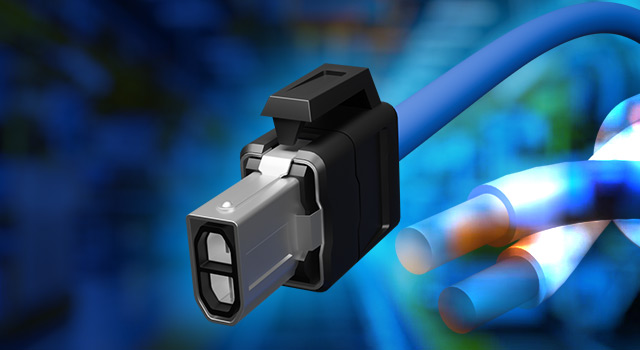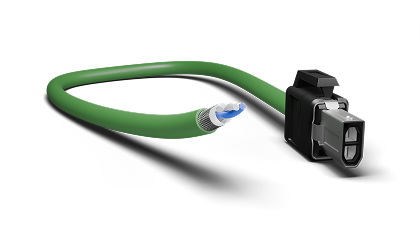

Signals+ ニュースレター登録
Signals+はコネクティビティ、デジタルヘルス、モビリティ、スマートインダストリーに関する最新情報をお届けします。
ありがとうございます。ご登録のメールアドレスにお送りしたメールを確認し、ニュースレター登録を完了させてください。
世界中の人々の生活に影響を与える、画期的なテクノロジーに関する最新情報をタイムリーにお届けします。
閉じるシングル・ペア・イーサネットによる革命 - 目的を持ったエンジニアリング、インパクトをもたらすイノベーション
モールス信号が開発されたのは、1800年代半ばのことです。それから1世紀以上にわたり、シングル・ペア・ケーブルは様々な産業分野で実施される通信を静かに支えていました。実際、シングル・ペア・ケーブルは信号を扱うシンプルなシステムから高度なデータ伝送システムに至るまで、あらゆる用途で活用されています。その実績から、同ケーブルが耐久性と適応性に優れていることは明らかです。
しかも、シングル・ペア・ケーブルの重要性は今日になってもますます高まっています。現在は、ソフトウェア定義型の自動車(SDV:Software-defined Vehicle)やスマート・インフラ、エネルギー効率に配慮して設計されたシステムといった新たなアプリケーションが続々と登場しています。それらのシステムでも、シングル・ペア・ケーブルを用いた接続が活用されます。つまり、シングル・ペア・ケーブルは次の世紀のイノベーションも支えていくのです。
遍在性と独創性の融合
ドアのベルや、HVAC(暖房、換気、空調)システム、高層ビルの防火ネットワークなど、シングル・ペア・ケーブルは建築物の環境に深く組み込まれています。また、最新の自動車においても、没入型のインフォテインメント・システムから先進運転支援システム(ADAS:Advanced Driver-assistance System)まで、あらゆるものを接続するためにシングル・ペア・ケーブルが使われています。
既存のインフラは銅線をベースとして構築されてきました。それらの銅線は単なるレガシーな存在ではなく、可能性を秘めたものだと言えます。その活用方法を見直せば、機器を設置する際の複雑さを軽減したり、より広い帯域幅を実現したりすることができます。また、既存のケーブルの多くを再利用することで、銅の採掘量や部材の廃棄量を最小限に抑えることが可能になります。つまり、将来の環境への影響を軽減できるということです。
実世界で性能を発揮するためのエンジニアリング
アプリケーションの規模が増大すれば、残念ながら技術的な課題の難易度も高まります。シングルツイスト・ペア・ケーブルによって高い信頼性でデータを伝送するには、以下のような点について事前に綿密な検討を行う必要があります。
- ケーブルの終端は電気的な反射を低減できるように最適化されているか?
- どの変調方式を採用すれば、エラー・レートを低く抑えることができるのか?
- システムの干渉を防ぐために、電磁環境適合性(EMC)の問題にどのように対処するのか?
- ネットワークのトポロジは将来の拡張性を考慮して設計されているか?
高い性能と優れたユーザ・エクスペリエンスを得るためには、上記のような事柄について慎重に決断を下す必要があります。例えば、標準規格を採用すれば安全性と相互運用性を確保できるはずです。しかし、どのようなソリューションを採用するのかを決定する際には、将来的なニーズも予測しなければなりません。


- システムのトポロジ:ポイントtoポイント/マルチドロップ
- 所有コスト:設置にかかるコスト、ケーブルのコスト
- アップリンク/ダウンリンクの速度:対称/非対称
- 全二重/半二重:エコーのキャンセル
- レイテンシ:リアルタイム・ネットワーク
- 距離:到達範囲
- 標準規格か、独自の規格か:市場での普及度合い
- レジリエンス:リンクの診断




未来を牽引する - 車載ネットワークにおけるシングル・ペア・ケーブル
最新の自動車では、シングル・ペア・ケーブルを使用した通信が広く使われています。その背景には、配線の簡素化、車両の軽量化、リアルタイムのデータ伝送といったニーズが存在します。シングルツイスト・ペア・ケーブルをベースとする通信技術には、以下のように様々なものがあります。
- A2B™(最高50Mbps):オーディオ、インフォテインメント
- 100BASE-T1(100Mbps):インフォテインメント、カメラ、ECU(Electronic Control Unit)
- 1000BASE-T1(1Gbps):高解像度のセンサー、ADAS
- E2B/10BASE-T1S(10Mbps):低速のセンサー、ゾーン・アーキテクチャ
- GMSL™(最高12Gbps):インフォテインメント、カメラ・システム
- CAN(最高8Mbps):ECUのネットワーク
これらのプロトコルのうちいくつかは標準規格であり、いくつかは独自の規格です。これらを組み合わせることにより、安全性、信頼性、効率を重視しつつ、堅牢性と拡張性に優れる車載ネットワークを構築できます。それによって得られるメリットは、単純な性能の向上にはとどまりません。ハーネスの削減、車両の軽量化、燃費の改善、設計の柔軟性の向上など多様なメリットを享受できます。
未来の工場自動化を支えるスマートなバックボーン技術
今日では、より高度な技術を導入したスマートな製造が求められています。そこで求められるコネクティビティについて言えば、単にデバイス間の接続を実現できればよいというわけではありません。そうではなく、インテリジェンスとアジリティを実現することが重要です。シングル・ペア・ケーブルを用いた通信は、工場のオペレーションを静かに変革しています。言い換えれば、産業自体の変革を実現するための重要な推進力になりつつあります。
単なる配線からインテリジェントなネットワークへ
従来、工場の製造フロアでは、センサー、コントローラ、機器などを相互接続するために、かさばる配線と階層化されたプロトコルが使用されていました。多くの場合、それらのシステムの設置や保守には多くのコストがかかります。また、アップグレードの手法については柔軟性の面で制限がありました。
シングル・ペア・イーサネット(SPE:Single Pair Ethernet)技術は、1対のツイストペア・ケーブルを使用することでイーサネットによる通信を実現するというものです。堅牢性の高いデータ伝送を実現できるだけでなく、コンパクトでコスト効率に優れるという特徴を備えています。産業分野を対象としてSPEの導入を検討するということは、ネットワークの拡張方法について戦略的に再考するということを意味します。SPEのミニマリズム的なアプローチがもたらすメリットは、単に部材を削減できるということにはとどまりません。例えば、以下のようなメリットを享受できます。
- より小型で軽量なケーブルを使用するので、狭い場所や可動式のアセンブリに容易に敷設できる
- 材料費と人件費を削減可能
- 迅速な試運転、診断の合理化を実現できる
- エネルギー効率の向上が期待できる
ITとOTの橋渡し
SPEを導入することで得られる非常に大きな効果の1つは、IT(Information Technology)とOT(Operational Technology)を橋渡しする能力が得られることです。例えば、SPEを採用した場合、最小レベルのセンサーを含むエッジ・デバイスにイーサネットで接続できるようになります。つまり、レイヤ間のプロトコルとインフラの統合が果たされます。工場のオートメーション・システムにSPEを適用した場合、以下のようなメリットが得られます。
- フィールド・デバイスからエンタープライズ・プラットフォームまでを網羅する形でデータの可視化をリアルタイムに実現できる
- 詳細かつタイムリーな知見に基づく予知保全を導入可能
- 需要に対して設備を動的に対応させる適応型の製造の実現を図れる
- データ・プロビナンスについては、IP(Internet Protocol)をベースとするシステムであればデータのソースで認証できる。つまり、セキュアで検証済みのデバイスによって生成されたデータであることを保証することが可能
インダストリ4.0は、このような融合(コンバージェンス)を推し進めることで具現化されます。SPEを採用すれば、大規模なコンバージェンスを実現することが可能になります。
過酷な現実に耐えられる設計
工場は、騒音や汚れなどが当たり前のように存在する過酷な環境です。そこで稼働する通信システムは、電気的な干渉、温度の変化、機械的な摩耗などに対応しつつ、厳しい許容誤差を維持しなければなりません。それらの課題に対処するには、SPEを採用してシステムを構築するとよいでしょう。そうすれば、信頼性の高いデータ伝送を実現できるだけの高いEMC性能が得られます。また、産業グレードの耐久性を実現する堅牢なコネクタを使用できます。更に、広大な施設に最適な長距離にわたる通信を実現可能です。
IEEE 802.3cg (10BASE-T1L) などの規格は、1kmを超える距離の通信をサポートしています。つまり、SPEを採用すれば、これまでアクセスできなかった場所までイーサネットによる通信範囲を拡大できます。
スリムで、コネクテッドで、インテリジェントな未来
シングル・ペア・ケーブルを利用するSPEは、単なる優れた配線ソリューションではありません。スマートで拡張性を備えた、持続可能なオートメーション機能を戦略的に実現するための基盤になります。SPEを採用すれば、ネットワークを簡素化し、性能を高め、工場の製造フロアでリアルタイムの応答性を得ることができます。産業界のリーダーたちは、より少ないリソースでより多くの成果を上げる方法を模索しています。SPEはその答えの1つになり得る技術です。実際、SPEは、よりスマートで、よりスリムで、よりインテリジェントな工場を実現するための道筋をもたらします。





 詳細を閉じる
詳細を閉じる


